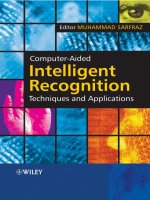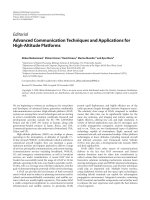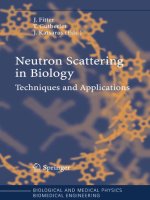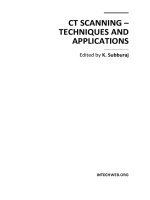computer-aided intelligent recognition techniques and applications
Bạn đang xem bản rút gọn của tài liệu. Xem và tải ngay bản đầy đủ của tài liệu tại đây (10.28 MB, 519 trang )
COMPUTER-AIDED
INTELLIGENT
RECOGNITION
TECHNIQUES AND
APPLICATIONS
Edited by
Muhammad Sarfraz
King Fahd University of Petroleum and Minerals, Kingdom of Saudi Arabia
COMPUTER-AIDED
INTELLIGENT
RECOGNITION
TECHNIQUES AND
APPLICATIONS
COMPUTER-AIDED
INTELLIGENT
RECOGNITION
TECHNIQUES AND
APPLICATIONS
Edited by
Muhammad Sarfraz
King Fahd University of Petroleum and Minerals, Kingdom of Saudi Arabia
Copyright © 2005 John Wiley & Sons Ltd, The Atrium, Southern Gate, Chichester,
West Sussex PO19 8SQ, England
Telephone (+44) 1243 779777
Email (for orders and customer service enquiries): cs-
Visit our Home Page on www.wiley.com
All Rights Reserved. No part of this publication may be reproduced, stored in a retrieval system or
transmitted in any form or by any means, electronic, mechanical, photocopying, recording,
scanning or otherwise, except under the terms of the Copyright, Designs and Patents Act 1988 or
under the terms of a licence issued by the Copyright Licensing Agency Ltd, 90 Tottenham Court
Road, London W1T 4LP, UK, without the permission in writing of the Publisher. Requests to the
Publisher should be addressed to the Permissions Department, John Wiley & Sons Ltd, The Atrium,
Southern Gate, Chichester, West Sussex PO19 8SQ, England, or emailed to ,
or faxed to +44 1243 770620.
Designations used by companies to distinguish their products are often claimed as trademarks.
All brand names and product names used in this book are trade names, service marks, trademarks or
registered trademarks of their respective owners. The Publisher is not associated with any
product or vendor mentioned in this book.
This publication is designed to provide accurate and authoritative information in regard to the subject
matter covered. It is sold on the understanding that the Publisher is not engaged in rendering
professional services. If professional advice or other expert assistance is required, the services of a
competent professional should be sought.
Other Wiley Editorial Offices
John Wiley & Sons Inc., 111 River Street, Hoboken, NJ 07030, USA
Jossey-Bass, 989 Market Street, San Francisco, CA 94103-1741, USA
Wiley-VCH Verlag GmbH, Boschstr. 12, D-69469 Weinheim, Germany
John Wiley & Sons Australia Ltd, 33 Park Road, Milton, Queensland 4064, Australia
John Wiley & Sons (Asia) Pte Ltd, 2 Clementi Loop #02-01, Jin Xing Distripark, Singapore 129809
John Wiley & Sons Canada Ltd, 22 Worcester Road, Etobicoke, Ontario, Canada M9W 1L1
Wiley also publishes its books in a variety of electronic formats. Some content that appears
in print may not be available in electronic books.
Library of Congress Cataloging-in-Publication Data
Sarfraz, Muhammad.
Computer-aided intelligent recognition techniques and applications / Muhammad Sarfraz.
p. cm.
Includes bibliographical references and Index.
ISBN-13 978-0-470-09414-3 (cloth)
ISBN-10 0-470-09414-1 (cloth)
1. Logic circuits—Computer-aided design. 2. Pattern perception. I. Title.
TK7868.L6S257 2005
006.3—dc22
2004030987
British Library Cataloguing in Publication Data
A catalogue record for this book is available from the British Library
ISBN-13 978-0-470-09414-3 (HB)
ISBN-10 0-470-09414-1 (HB)
Typeset in 9/11pt Times by Integra Software Services Pvt. Ltd, Pondicherry, India
Printed and bound in Great Britain by Antony Rowe Ltd, Chippenham, Wiltshire
This book is printed on acid-free paper responsibly manufactured from sustainable forestry
in which at least two trees are planted for each one used for paper production.
Contents
Preface xvii
List of Contributors xix
1. On Offline Arabic Character Recognition 1
Muhammad Sarfraz, Abdulmalek Zidouri and Syed Nazim Nawaz
(Kingdom of Saudi Arabia)
1. Introduction 1
2. Structure of the Proposed OCR System 4
3. Preprocessing 6
4. Segmentation 7
4.1 Line Segmentation and Zoning 8
4.2 Word Segmentation 8
4.3 Segmentation of Words into Individual Characters 9
5. Feature Extraction 10
6. Recognition Strategy 11
6.1 Recognition Using the Syntactic Approach 12
6.2 Recognition Using the Neural Network Approach 13
7. Experimental Results and Analysis 15
7.1 System Training 15
7.2 Experimental Set-up 15
7.3 Results Achieved 15
8. Conclusion 17
Acknowledgement 17
References 17
2. License Plate Recognition System: Saudi Arabian Case 19
Muhammad Sarfraz and Mohammed Jameel Ahmed (Kingdom of Saudi Arabia)
1. Introduction 19
2. Structure of a Typical LPR System 20
3. Image Acquisition 21
4. License Plate Extraction 21
4.1 Vertical Edge Detection 23
4.2 Filtering 23
4.3 Vertical Edge Matching 24
4.4 Black to White Ratio and Plate Extraction 26
5. License Plate Segmentation 26
vi Contents
6. Character Recognition 26
6.1 Normalization 26
6.2 Template Matching 27
7. Experimental Analysis and Results 27
8. Conclusion 32
References 32
3. Algorithms for Extracting Textual Characters in Color Video 33
Edward K. Wong and Minya Chen (USA)
1. Introduction 33
2. Prior and Related Work 34
3. Our New Text Extraction Algorithm 35
3.1 Step 1: Identify Potential Text Line Segments 36
3.2 Step 2: Text Block Detection 38
3.3 Step 3: Text Block Filtering 38
3.4 Step 4: Boundary Adjustments 38
3.5 Step 5: Bicolor Clustering 38
3.6 Step 6: Artifact Filtering 39
3.7 Step 7: Contour Smoothing 39
4. Experimental Results and Performance 40
5. Using Multiframe Edge Information to Improve Precision 47
5.1 Step 3(b): Text Block Filtering Based on Multiframe Edge Strength 47
6. Discussion and Concluding Remarks 47
References 48
4. Separation of Handwritten Touching Digits: A Multiagents Approach 51
Ashraf Elnagar (UAE) and Reda Al-Hajj (Canada)
1. Introduction 51
2. Previous Work 52
3. Digitizing and Processing 56
4. Segmentation Algorithm 56
4.1 Extraction of Feature Points 56
4.2 The Employed Agents 57
5. Experimental Results 61
6. Conclusions and Future Work 65
References 65
5. Prototype-based Handwriting Recognition Using Shape and Execution Prototypes 67
Miguel L. Bote-Lorenzo, Eduardo Gómez-Sánchez and Yannis A. Dimitriadis (Spain)
1. Introduction 67
2. A Handwriting Generation Process Model 68
3. The First Stages of the Handwriting Recognition System 70
3.1 Character Segmentation 70
3.2 Feature Extraction 71
4. The Execution of the Prototype Extraction Method 73
4.1 Grouping Training Samples 74
4.2 Refinement of the Prototypes 75
4.3 Experimental Evaluation of the Prototype Extraction Method 76
5. Prototype-based Classification 82
5.1 The Prototype-based Classifier Architecture 82
5.2 Experimental Evaluation of the Prototype Initialization 83
Contents vii
5.3 Prototype Pruning to Increase Knowledge Condensation 84
5.4 Discussion and Comparison to Related Work 85
6. Conclusions 87
Acknowledgement 87
References 87
6. Logo Detection in Document Images with Complex Backgrounds 89
Tuan D. Pham and Jinsong Yang (Australia)
1. Introduction 89
2. Detection of Potential Logos 90
3. Verification of Potential Logos 91
3.1 Feature Extraction by Geostatistics 91
3.2 Neural Network-based Classifier 93
4. Experimental Results 93
5. Conclusions 97
References 97
7. An Intelligent Online Signature Verification System 99
Bin Li (China) and David Zhang (Hong Kong)
1. Introduction 99
1.1 Process and System 100
1.2 The Evaluation of an Online Signature Verification System 101
2. Literature Overview 102
2.1 Conventional Mathematical Approaches 102
2.2 Dynamic Programming Approach 104
2.3 Hidden Markov Model-Based Methods 105
2.4 The Artificial Neural Networks Approach 106
2.5 Signature Verification Product Market Survey 106
3. A Typical Online Signature Verification System 107
3.1 Data Acquisition 107
3.2 Feature Extraction 110
3.3 Feature Matching 111
3.4 Verification 112
4. Proposed Online Signature Verification Applications 113
4.1 System Password Authentication 113
4.2 Internet E-commerce Application 114
5. Conclusions 116
References 116
8. Hybrid Fingerprint Recognition using Minutiae and Shape 119
Asker Bazen, Raymond Veldhuis and Sabih Gerez (The Netherlands)
1. Introduction 119
2. Elastic Deformations 120
3. Elastic Minutiae Matching 122
3.1 Local Minutiae Matching 122
3.2 Global Minutiae Matching 123
4. Shape Matching 126
5. Results 126
6. Conclusions 129
Acknowledgement 129
References 129
viii Contents
9. Personal Authentication Using the Fusion of Multiple Palm-print Features 131
Chin-Chuan Han (Taiwan, R.O.C.)
1. Introduction 131
2. Preprocessing 133
2.1 Step 1: Image Thresholding 134
2.2 Step 2: Border Tracing 134
2.3 Step 3: Wavelet-based Segmentation 135
2.4 Step 4: Region of Interest (ROI) Generation 135
3. Feature Extraction 135
4. Enrollment and Verification Processes 136
4.1 Multitemplate Matching Approach 136
4.2 Multimodal Authentication with PBF-based Fusion 137
4.3 Adaptive Thresholding 139
5. Experimental Results 140
5.1 Experimental Environment 140
5.2 Verification Using a Template Matching Algorithm 140
5.3 Verification Using PBF-based Fusion 141
6. Conclusions 142
References 142
10. Intelligent Iris Recognition Using Neural Networks 145
Muhammad Sarfraz, Mohamed Deriche, Muhammad Moinuddin
and Syed Saad Azhar Ali (Kingdom of Saudi Arabia)
1. Introduction 145
2. Literature Review 147
3. Some Groundbreaking Techniques 148
3.1 Daugman’s Method 149
3.2 Boles’s Method 150
3.3 Method of Dyadic Wavelet Transform Zero Crossing 151
4. Neural Networks 154
4.1 Multilayer Feed-forward Neural Networks (MFNNs) 154
4.2 Radial Basis Function Neural Networks (RBFNNs) 156
5. Proposed Method 158
5.1 Localizing the Iris 158
5.2 Finding the Contour 159
5.3 Feature Extraction 159
5.4 Iris Pattern Recognition 162
6. Experimental Results 162
6.1 Results for an MFNN 162
6.2 Results for an RBFNN 162
7. Graphic User Interface (GUI) 164
8. Concluding Remarks 166
References 166
11. Pose-invariant Face Recognition Using Subspace Techniques 169
Mohamed Deriche and Mohammed Aleemuddin (Kingdom of Saudi Arabia)
1. Introduction 169
1.1 Background 170
1.2 The Problem of Pose 171
Contents ix
2. Review of Biometric Systems 172
2.1 Summary of the Performance of Different Biometrics 173
2.2 Selecting the Right Biometric Technology 177
2.3 Multimodal Biometric Systems 177
3. Face Recognition Algorithms 178
3.1 Template-based Face Recognition 180
3.2 Appearance-based Face Recognition 180
3.3 Model-based Face Recognition 181
4. Linear Subspace Techniques 183
4.1 Principal Component Analysis 184
4.2 Linear Discriminant Analysis 185
4.3 Independent Component Analysis 189
5. A Pose-invariant System for Face Recognition 191
5.1 The Proposed Algorithm 192
5.2 Pose Estimation using LDA 192
5.3 Experimental Results for Pose Estimation using LDA and PCA 194
5.4 View-specific Subspace Decomposition 194
5.5 Experiments on the Pose-invariant Face Recognition System 195
6. Concluding Remarks 198
References 198
12. Developmental Vision: Adaptive Recognition of Human Faces
by Humanoid Robots 201
Hon-fai Chia and Ming Xie (Singapore)
1. Introduction 201
2. Adaptive Recognition Based on Developmental Learning 202
2.1 Human Psycho-physical Development 202
2.2 Machine (Robot) Psycho-physical Development 203
2.3 Developmental Learning 204
2.4 Questions to Ponder 204
3. Developmental Learning of Facial Image Detection 205
3.1 Current Face Detection Techniques 205
3.2 Criteria of Developmental Learning for Facial Image Detection 206
3.3 Neural Networks 206
3.4 Color Space Transformation 207
3.5 RCE Adaptive Segmentation 210
3.6 Implementation 218
3.7 Questions to Ponder 218
3.8 Experimental Results 220
4. Developmental Learning of Facial Image Recognition 222
4.1 Wavelets 222
4.2 Wavelet Packet Analysis 223
4.3 Feature Extraction by Wavelet Packet Analysis 224
4.4 Hidden Markov Models 227
4.5 Feature Classification by Hidden Markov Models 234
4.6 Questions to Ponder 234
4.7 Experimental Results 235
5. Discussion 236
References 237
x Contents
13. Empirical Study on Appearance-based Binary Age Classification 241
Mohammed Yeasin, Rahul Khare and Rajeev Sharma (USA)
1. Introduction 242
2. Related Works 243
3. Description of the Proposed Age Classification System 243
3.1 Database 244
3.2 Segmentation of the Facial Region 245
3.3 Preprocessing 246
3.4 Feature Extraction 246
3.5 Classifying People into Age Groups 246
4. Empirical Analysis 247
4.1 Performance of Data Projection Techniques 247
4.2 The Effect of Preprocessing and Image Resolution 248
4.3 The Effect of Pose Variation 248
4.4 The Effect of Lighting Conditions 249
4.5 The Effect of Occlusion 249
4.6 The Impact of Gender on Age Classification 250
4.7 Classifier Accuracies Across the Age Groups 251
5. Conclusions 252
Appendix A: Data Projection Techniques 253
A.1 Principal Component Analysis (PCA) 253
A.2 Non-Negative Matrix Factorization (NMF) 253
Appendix B: Fundamentals of Support Vector Machines 253
Acknowledgement 254
References 254
14. Intelligent Recignition in Medical Pattern Understanding and Cognitive Analysis 257
Marek R. Ogiela and Ryszard Tadeusiewicz (Poland)
1. Introduction 257
2. Preliminary Transformation of Medical Images 259
3. Structural Descriptions of the Examined Structures 261
4. Coronary Vessel Cognitive Analysis 263
5. Understanding of Lesions in the Urinary Tract 265
6. Syntactic Methods Supporting Diagnosis of Pancreatitis and Pancreatic Neoplasm 268
7. Semantic Analysis of Spinal Cord NMR Images 271
8. Conclusions 272
References 273
15. The Roadmap for Recognizing Regions of Interest in Medical Images 275
Sabah M.A. Mohammed, Jinan A.W. Fiaidhi and Lei Yang (Canada)
1. Introduction 275
2. Convolutional Primitive Segmentation 276
3. Thresholding Primitive Segmentation 280
4. Morphological Primitive Segmentation 280
4.1 Erosion 280
4.2 Dilation 281
4.3 Opening and Closing 281
5. Hybridizing the Primitive Segmentation Operators 281
Contents xi
6. Region Identification Based on Fuzzy Logic 285
6.1 Experimental Results 289
7. Conclusions 293
References 294
16. Feature Extraction and Compression with Discriminative and Nonlinear
Classifiers and Applications in Speech Recognition 297
Xuechuan Wang (Canada)
1. Introduction 298
2. Standard Feature Extraction Methods 300
2.1 Linear Discriminant Analysis 300
2.2 Principal Component Analysis 301
3. The Minimum Classification Error Training Algorithm 301
3.1 Derivation of the MCE Criterion 301
3.2 Using MCE Training Algorithms for Dimensionality Reduction 303
4. Support Vector Machines 304
4.1 Constructing an SVM 304
4.2 Multiclass SVM Classifiers 306
5. Feature Extraction and Compression with MCE and SVM 307
5.1 The Generalized MCE Training Algorithm 307
5.2 Reduced-dimensional SVM 307
6. Classification Experiments 308
6.1 Deterding Database Experiments 309
6.2 TIMIT Database Experiments 311
7. Conclusions 316
References 317
17. Improving Mine Recognition through Processing and Dempster–Shafer Fusion
of Multisensor Data 319
Nada Milisavljevi
´
c (Belgium) and Isabelle Bloch (France)
1. Introduction 319
2. Data Presentation and Preprocessing 320
2.1 IR Data 320
2.2 GPR Data 321
2.3 MD Data 323
3. Region Selection 324
3.1 IR Regions 324
3.2 GPR Regions 325
3.3 MD Regions 325
4. Choice of Measures and Their Extraction 327
4.1 IR Measures 327
4.2 GPR Measures 328
4.3 MD Measures 333
5. Modeling of Measures in Terms of Belief Functions and Their Discounting 333
5.1 IR Measures 334
5.2 GPR A-scan and Preprocessed C-scan Measures 335
5.3 GPR B-scan (Hyperbola) Measures 336
5.4 MD Measures 336
5.5 Discounting Factors 337
xii Contents
6. Region Association, Combination of Measures and Decision 338
6.1 Region Association 338
6.2 Combination of Masses 339
6.3 Decision 340
7. Results 341
8. Conclusion 341
Acknowledgement 342
References 342
18. Fast Object Recognition Using Dynamic Programming from a Combination
of Salient Line Groups 345
Dong Joong Kang, Jong Eun Ha and In So Kweon (Korea)
1. Introduction 345
2. Previous Research 346
3. Junction Extraction 347
4. Energy Model for the Junction Groups 348
5. Energy Minimization 349
6. Collinear Criterion of Lines 351
6.1 Parallelism 351
6.2 Normal Distance 352
7. Energy Model for the Junction Groups 353
8. Experiments 354
8.1 Line Group Extraction 355
8.2 Collinearity Tests for Random Lines 359
9. Conclusions 360
References 360
19. Holo-Extraction and Intelligent Recognition of Digital Curves Scanned
from Paper Drawings 363
Ke-Zhang Chen, Xi-Wen Zhang, Zong-Ying Ou and Xin-An Feng (China)
1. Introduction 363
2. Review of Current Vectorization Methods 364
2.1 The Hough Transform-based Method 365
2.2 Thinning-based Methods 365
2.3 The Contour-based Method 365
2.4 The Sparse Pixel-based Method 365
2.5 Mesh Pattern-based Methods 365
2.6 Black Pixel Region-based Methods 366
2.7 The Requirements for Holo-extraction of Information 366
3. Construction of the Networks of SCRs 367
3.1 Generating Adjacency Graphs of Runs 367
3.2 Constructing Single Closed Regions (SCRs) 368
3.3 Building Adjacency Graphs of SCRs 370
3.4 Constructing the Networks of SCRs 371
4. A Bridge from the Raster Image to Understanding and 3D Reconstruction 373
4.1 Separating the Annotations and the Outlines of Projections of Parts 373
4.2 Vectorization 375
4.3 3D Reconstruction 377
Contents xiii
5. Classification of Digital Curves 379
5.1 Extracting the Representative Points of Digital Curves 379
5.2 Fitting a Straight line to the Set of Points 380
5.3 Fitting a Circular Arc to the Set of Points 381
5.4 Determining the Type 382
6. Decomposition of Combined Lines Using Genetic Algorithms 382
6.1 Initial Population 382
6.2 Fitness Function 384
6.3 Crossover 384
6.4 Mutation 384
6.5 Selection 385
6.6 Convergence and Control Parameters 385
6.7 Determination of the Relationships Between the Segments 385
6.8 Software Prototype 386
7. Conclusions 386
References 387
20. Topological Segmentation and Smoothing of Discrete Curve Skeletons 389
Wenjie Xie, Renato Perucchio, David Sedmera and Robert P. Thompson (USA)
1. Introduction 389
2. Basic Definitions 390
3. Topological Segmentation 392
3.1 Component Counting and Labeling 392
3.2 Classification of Skeleton Voxels 392
3.3 Local Junction Classification 393
3.4 Thick Junction Resolution 394
3.5 Branch Formation 395
4. Branch Filtering 397
4.1 Branch Classification 397
4.2 Noise Segment Removal 398
5. Branch Smoothing 400
5.1 Polynomial Branch Representation 400
5.2 Augmented Merit Functions 401
6. Results 403
7. Discussion 407
Acknowledgement 408
References 408
21. Applications of Clifford-valued Neural Networks to Pattern Classification
and Pose Estimation 411
Eduardo Bayro-Corrochano and Nancy Arana-Daniel (México)
1. Introduction 411
2. Geometric Algebra: An Outline 412
2.1 Basic Definitions 412
2.2 The Geometric Algebra of nD Space 413
2.3 The Geometric Algebra of 3D Space 414
2.4 Rotors 414
2.5 Conformal Geometric Algebra 415
3. Real-valued Neural Networks 416
4. Complex MLP and Quaternionic MLP 417
xiv Contents
5. Clifford-valued Feed-forward Neural Networks 418
5.1 The Activation Function 418
5.2 The Geometric Neuron 418
5.3 Feed-forward Clifford-valued Neural Networks 419
6. Learning Rule 421
6.1 Multidimensional Back-propagation Training Rule 421
6.2 Geometric Learning Using Genetic Algorithms 422
7. Support Vector Machines in the Geometric Algebra Framework 422
7.1 Support Vector Machines 422
7.2 Support Multivector Machines 423
7.3 Generating SMVMs with Different Kernels 424
7.4 Design of Kernels Involving the Clifford Geometric Product
for Nonlinear Support Multivector Machines 424
7.5 Design of Kernels Involving the Conformal Neuron 425
8. Clifford Moments for 2D Pattern Classification 426
9. Experimental Analysis 428
9.1 Test of the Clifford-valued MLP for the XOR Problem 428
9.2 Classification of 2D Patterns in Real Images 429
9.3 Estimation of 3D Pose 431
9.4 Performance of SMVMs Using Kernels Involving the Clifford Product 432
9.5 An SMVM Using Clustering Hyperspheres 434
10. Conclusions 436
References 436
22. Intelligent Recognition: Components of the Short-time Fourier
Transform vs. Conventional Approaches 439
Leonid Gelman, Mike Sanderson, Chris Thompson and Paul Anuzis (UK)
1. Introduction 440
2. Theoretical Analysis 440
3. Application 447
4. Conclusions 448
Acknowledgement 450
References 450
23. Conceptual Data Classification: Application for Knowledge Extraction 453
Ahmed Hasnah, Ali Jaoua and Jihad Jaam (Qatar)
1. Introduction 453
2. Mathematical Foundations 454
2.1 Definition of a Binary Context 454
2.2 Definition of a Formal Concept 455
2.3 Galois Connection 456
2.4 Optimal Concept or Rectangle 457
3. An Approximate Algorithm for Minimal Coverage of a Binary Context 459
4. Conceptual Knowledge Extraction from Data 462
4.1 Supervised Learning by Associating Rules to Optimal Concepts 462
4.2 Automatic Entity Extraction from an Instance of a Relational Database 463
4.3 Software Architecture Development 465
4.4 Automatic User Classification in the Network 465
5. Conclusion 465
References 466
Contents xv
24. Cryptographic Communications With Chaotic Semiconductor Lasers 469
Andrés Iglesias (Spain)
1. Introduction 470
2. Semiconductor Lasers with Optical Feedback 472
2.1 Step 1: Choice of the Laser 472
2.2 Step 2: Determination of the Laser Equations and Parameters 473
2.3 Step 3: Choice of Some Accessible Parameter for Chaoticity 475
2.4 Step 4: Synchronization of the Chaotic Transmitter and Receiver Systems 476
3. Applications to Cryptographic Communications 478
3.1 Chaotic Masking 478
3.2 Chaotic Switching 479
4. Conclusions 481
References 482
Index 485
Preface
Intelligent recognition techniques, applications, systems and tools are extremely useful in a number
of academic and industrial settings. Specifically, intelligent recognition plays a significant role
in multidisciplinary problem solving. It is extremely useful for personal identification in various
situations like security, banking, police, postal services, etc. In particular, various problems like
character recognition, iris recognition, license plate recognition, fingerprint recognition, signature
recognition, recognition in medical pattern understanding, mine recognition, and many others can be
intelligently solved and automated. In addition to its critical importance in the traditional fields of
character recognition, natural language processing and personal identification, more recently, intelligent
recognition methods have also proven to be indispensable in a variety of modern industries, including
computer vision, robotics, medical imaging, visualization, and even media.
This book aims to provide a valuable resource, which focuses on interdisciplinary methods and
affiliated up-to-date methodologies in the area. It aims to provide the user community with a variety
of techniques, applications, systems and tools necessary for various real-life problems in areas such as:
•
Information Technology
•
Education
•
Security
•
Banking
•
Police
•
Postal services
•
Manufacturing
•
Mining
•
Medicine
•
Multimedia
•
Entertainment
•
Communications
•
Data visualization
•
Knowledge extraction
•
Pattern classification
•
Pose estimation
•
Virtual reality
•
Others
It aims to collect and disseminate information in various disciplines including:
•
Pattern recognition
•
Artificial Intelligence
•
Computer vision
•
Computer graphics
•
Image processing
•
Neural networks
•
Cryptography
•
Fuzzy logic
•
Databases
•
Evolutionary algorithms
•
Shape analysis and
description
•
Numerical analysis
•
Others
The major goal of this book is to stimulate views and provide a source from which students,
researchers and practitioners can find the latest developments in the field of intelligent recognition.
Due to speedy scientific developments, there is a great deal of thirst within the scientific community
worldwide to be equipped with state-of-the-art and up-to-date theory and practice to get their problems
solved in diverse areas of various disciplines. Although a good deal of work has been done by
xviii Preface
researchers, yet interest is increasing tremendously everyday due to complicated problems being faced
in academia and industry.
The twenty-four chapters within this book will cover computer-aided intelligent recognition
techniques, applications, systems and tools. The book is planned to be of most use to researchers,
computer scientists, practising engineers, and many others who seek state-of-the-art techniques,
applications, systems and tools for intelligent recognition. It will also be equally and extremely useful
for undergraduate senior students, as well as graduate students, in the areas of computer science,
engineering, and other computational sciences.
The editor is thankful to the contributors for their valuable efforts towards the completion of this
book. A lot of credit is also due to the various experts who reviewed the chapters and provided helpful
feedback. The editor is happy to acknowledge the support of King Fahd University of Petroleum and
Minerals towards the compilation of this book. The project has been funded by King Fahd University
of Petroleum and Minerals under Project # ICS/INT.RECOGNITION/271.
M. Sarfraz
List of Contributors
Ahmed, M. J.
Aleemuddin, M.
Al-Hajj, R.
Ali, S. S. A.
Anuzis, P.
Arana-Daniel, N.
Bayro-Corrochano, E.
Bazen, A.
Bloch, I.
Bote-Lorenzo, M. L.
Chen, K-Z.
Chen, M.
Chia, H-F.
Deriche, M.
Dimitriadis, Y. A.
Elnagar, A.
Feng, X. A.
Fiaidhi, J. A. W.
Gelman, L.
Gerez, S.
Gómez-Sánchez, E.
Ha, J. E.
Han, C-C.
Hasnah, A.
Iglesias, A.
Jaam, J.
Jaoua, A.
Kang, D. J.
Khare, R.
Kweon, I. S.
Li, B.
Milisavljevi
´
c, N.
Mohammed, S. M. A.
Moinuddin, M.
Nawaz, S. N.
Ogiela, M. R
Ou, Z-Y.
Perucchio, R.
xx List of Contributors
Pham, T. D.
Sanderson, M.
Sarfraz, M.
Sedmera, D.
Sharma, R.
Tadeusiewicz, R.
Thompson, C.
Thompson, R. P.
Veldhuis, R.
Wang, X.
Wong, E. K.
Xie, M.
Xie, W
Yang, J.
Yang, L.
Yeasin, M.
Zhang, D.
Zhang, X-W.
Zidouri, A.
1
On Offline Arabic Character
Recognition
Muhammad Sarfraz
Department of Information and Computer Science, King Fahd University of Petroleum and
Minerals, Dhahran 31261, Kingdom of Saudi Arabia
Abdulmalek Zidouri
Department of Electrical Engineering, King Fahd University of Petroleum and Minerals,
Dhahran 31261, Kingdom of Saudi Arabia
Syed Nazim Nawaz
Information Technology Department, College of Business Administration, Jeddah 21361,
Kingdom of Saudi Arabia
Machine recognition of characters has received considerable research interest in the area of pattern
recognition in the past few decades. This chapter presents the design and implementation of a system
that recognizes machine printed Arabic characters. The proposed system consists of four stages:
preprocessing of the text, segmentation of the text into individual characters, feature extraction using
the moment invariant technique and recognition of characters based on two approaches. In the
preprocessing of the text we deal with two problems: isolated pixel removal and drift detection and
correction. Next, the given text is segmented into individual characters using horizontal and vertical
projection profiles. Moment invariants are used for feature extraction for each character. Finally, the
system is trained and the characters are recognized. Recognition of characters is attempted using two
approaches, a syntactic approach and a neural network approach.
1. Introduction
In the past two decades, valuable work has been carried out in the area of character recognition and
a large number of technical papers and reports have been devoted to this topic. Character recognition
systems offer potential advantages by providing an interface that facilitates interaction between man
Computer-Aided Intelligent Recognition Techniques and Applications Edited by M. Sarfraz
© 2005 John Wiley & Sons, Ltd
2 Offline Arabic Character Recognition
and machine. Some of the applications of OCR include automatic processing of data, check verification
and a large variety of banking, business and scientific applications. OCR provides the advantage of
little human intervention and higher speed in both data entry and text processing, especially when the
data already exists in machine-readable forms.
With all the above advantages considered, Arabic character recognition proves to be an interesting
area for research. Many papers concerned with Optical Character Recognition (OCR) have been
reported in the literature [1]. Several recognition techniques have been used over the past few decades
by many researchers. These techniques were applied for the automatic recognition of both machine
and hand-printed characters. An immense amount of research has been carried out on the recognition
of Latin and Chinese characters. Against this background, only few papers have addressed the problem
of Arabic character recognition. One of the main reasons behind this is the difficulty involved in
processing printed Arabic text. The connectivity and variant shape of characters in different word
positions present significant difficulty in processing of the text. Some of the features of Arabic script
that have limited the research in this area are the following:
•
Arabic script constitutes 28 characters, in addition to ten numerals.
•
Each character can appear in four different shapes/forms depending on the position of the word
(Beginning form, BF; Middle form, MF; Isolated form, IF; and End form, EF). Table 1.1 shows
some Arabic characters in their different forms.
•
The Arabic characters of a word are connected along a baseline. A baseline is the line with the
highest density of black pixels. This calls for different segmentation methods from those used in
other unconnected scripts.
•
Characters in Arabic script are connected even when typed or printed.
•
In addition to connectivity, vowel diacritic signs are an essential part of written Arabic. Vowels are
represented in the form of overscores or underscores (see Figure 1.1).
Table 1.1 Different forms of Arabic characters.
Introduction 3
Figure 1.1 The baseline and diacritics of a given Arabic text.
Figure 1.2 Example of different characters with the same body.
•
Many Arabic characters have dots, which are positioned above or below the letter body. Dots can
be single, double or triple. Different Arabic letters can have the same body and differ in the number
of dots identifying them, as shown in Figure 1.2.
•
The problem of overlapping makes the problem of determination of spacing between characters and
words difficult.
•
Characters in an Arabic script usually overlap with their neighboring letters depending on their
position in the word. The degree of overlapping varies depending on the size and style of the
character.
Figure 1.3 depicts some of the features of Arabic script. As shown in the figure, the ligature in the
beginning and the middle of the figure consists of two vertically stacked characters. The text baseline
is between the two horizontal lines. The text shown in Figure 1.3 is a text with diacritics.
These and other special characteristics make it impossible to directly adapt English or other text
recognition systems to Arabic text recognition.
The rest of the chapter is organized as follows: Section 2 describes the structure of the proposed
OCR system and the work that has been carried out in this area. The preprocessing stage is explained in
Section 3. Section 4 discusses the proposed method for segmentation of text into individual characters.
Section 5 explains feature extraction based on the moment invariant technique by Hu [2]. Section 6
Under segmented
Character
diacritics
ligature
no overlap
baseline
overlap
Figure 1.3 The characteristics of an Arabic text.









